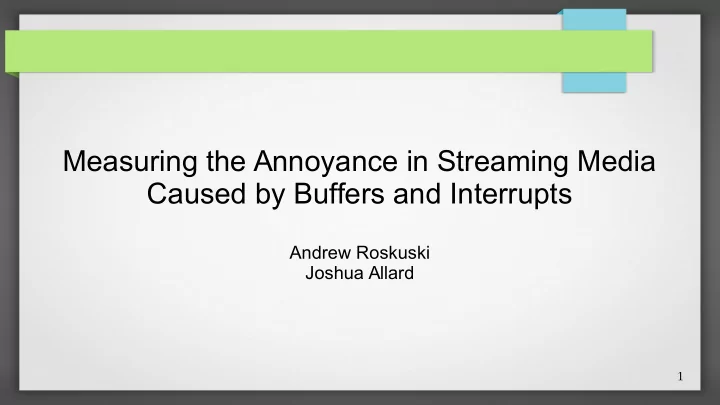

Measuring the Annoyance in Streaming Media Caused by Buffers and Interrupts Andrew Roskuski Joshua Allard 1
Introduction ● Streaming media is very important to today's culture – Online videos ● Annoyance with streaming media – Associated with the defects in the playback – Lacking research into the matter 2
Introduction – Buffers ● Buffers: Wait time at the beginning of the video 3
Introduction – Interrupts ● Interrupts: Pauses during the playback 4
Introduction – Motion ● The level of motion in a video is the amount of the image that changes over time 5
Outline ● Problem Statement ● Hypotheses ● Methodology ● Results and Analysis ● Conclusion 6
Problem Statement ● Assuming annoyance in streaming media is unavoidable, how do minimize it? – How do Buffers and Interrupts annoy the user? – Does the level of motion in the video have any affect on this annoyance? 7
Hypotheses 8
Hypotheses 9
Methodology ● Prepared videos – Found videos to fill our motion categories – Inserted Buffers and Interrupts into videos ● Created survey to display videos to users and ask about their perceived annoyance – Demographic Questions – Video Questions 10
Methodology – Survey (Demographic Page) Questions: ● Age ● Gender ● Major ● Streaming Video Experience 11
Methodology – Survey (Video Page) 12
Results – Demographics 100% Total Participants: 37 80% 60% 40% Mechanical Engineering 20% Math 0% Male Female Environmental Engineering Electrical and Computer Engineering SONA Computer Science/IMGD Announcement Chemistry/Chemical Engineering/Biochemistry Business Email Biology/Biomedical Engineering/Biotechnology Referral Aerospace Engineering 0% 20% 40% 60% 80% 100% 0% 20% 40% 60% 80% 100% 13
Results – Buffers 5 f ( buffer ) ( x )=− 0.01 x 2 + 0.16 x + 1.32 4 Annoyance Rating 3 2 1 0 2 4 6 8 10 12 14 16 Buffer Time (seconds) 14
Results – Interrupts 5 4 Annoyance Rating 3 2 f ( interrupt ) ( x )= 0.75ln ( x )+ 1.98 1 0 2 4 6 8 10 12 14 16 Interrupt Count 15
Results – Interrupts and Motion ● Low Motion had the highest annoyance rating 5 4 Low Annoyance Rating Medium Low 3 Medium High High 2 1 0 2 4 6 8 10 12 14 16 Interrupt Count 16
Results – Theoretical Impact f estimated-total-annoyance = Min ( f buffer ( x )+ f interrupt ( y ) , 5 ) f min-annoyance = Max ( f buffer ( x ) ,f interrupt ( y )) 17
Conclusions ● Annoyance vs buffer time fits to a degree-2 polynomial – The value does not vary with motion level ● Annoyance vs interrupt count fits to a logarithmic function – The value is highest with the low motion category 18
Future Work ● Understand the combined annoyance relationship between buffers and interrupts ● Look for other factors that might affect a user's annoyance – Video Content – Sound 19
The End Are there any questions? 20
Recommend
More recommend